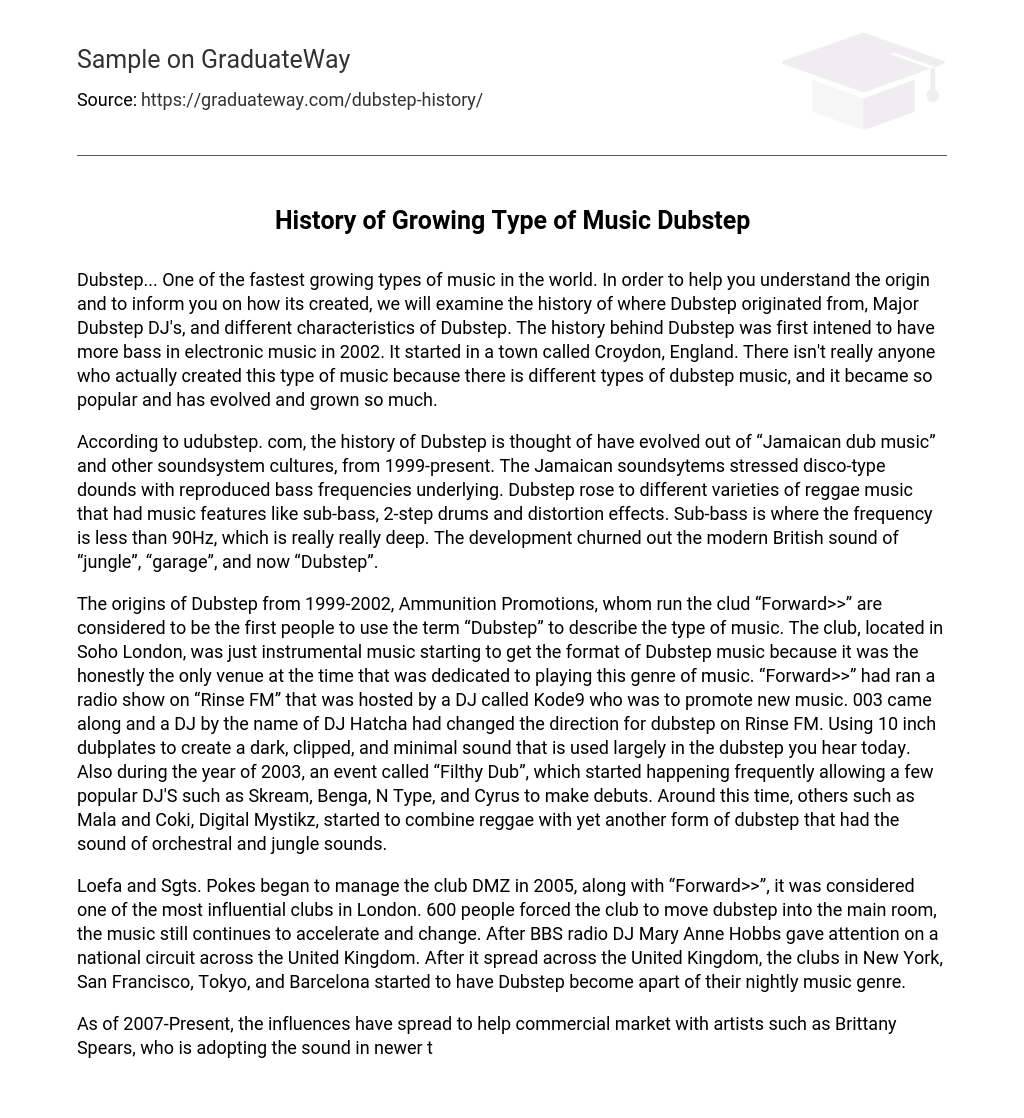Dubstep, a genre of music that emerged in Croydon, England in 2002, is experiencing rapid growth. Its roots can be traced back to the demand for increased bass in electronic music. Although dubstep encompasses various styles and lacks a singular creator, it has achieved widespread acclaim and continues to evolve and thrive. To gain insight into its beginnings, production methods, and distinctive attributes, we will delve into the history, notable DJs, and diverse components of dubstep.
According to udubstep.com, Dubstep’s history is believed to have originated from Jamaican dub music and other soundsystem cultures, spanning from 1999 to the present day. The Jamaican soundsystems focused on disco-like sounds with pronounced bass frequencies. Dubstep emerged from different types of reggae music that incorporated features such as sub-bass, 2-step drums, and distortion effects. Sub-bass refers to frequencies below 90Hz, which are exceptionally deep. This progression gave rise to the contemporary British genres of “jungle,” “garage,” and ultimately, “Dubstep.”
The term “Dubstep” was first used to describe a type of music by Ammunition Promotions, who ran the club “Forward>>” from 1999-2002. This club, located in Soho London, was instrumental in shaping the format of Dubstep music at the time as it was dedicated solely to this genre. “Forward>>” also had a radio show on “Rinse FM” hosted by DJ Kode9, which aimed to promote new music. In 2003, DJ Hatcha changed the direction of dubstep on Rinse FM by using 10 inch dubplates that created a dark, clipped, and minimal sound that is still prevalent in today’s dubstep. During this time, an event called “Filthy Dub” started happening frequently and featured popular DJs like Skream, Benga, N Type, and Cyrus making their debuts. Additionally, artists like Mala and Coki, from Digital Mystikz, began combining reggae with a different form of dubstep that incorporated orchestral and jungle sounds.
Loefa and Sgts. Pokes assumed control of DMZ club in 2005, which was widely considered one of London’s most influential clubs alongside “Forward>>”. With the support of 600 people, the club made the decision to bring dubstep into the main room, causing its music to continuously evolve and gain popularity. Thanks to BBS radio DJ Mary Anne Hobbs’ promotion, dubstep started gaining nationwide attention throughout the United Kingdom. As a result, it expanded its presence to clubs in New York, San Francisco, Tokyo, and Barcelona where it became an essential part of their nightly music scene.
From 2007 to the present, dubstep has had a significant impact on the commercial market. Artists like Brittany Spears have embraced the dubstep sound in their newer tracks. In 2010, songs such as “I Need Air” by Magnetic Man became popular on the UK pop charts, marking a notable period in the dubstep music scene from 2010 to 2011.
This era witnessed progressive artists like Flux Pavilion, Noisia, Bassnectar, and Zeds Dead redefining the traditional dub sound. Additionally, artists like “Knife Party” (pictured above) dominated the contemporary dubstep world by incorporating more mid-range bass and vocals.
In an attempt to integrate widely accepted club music, up-and-coming artists are combining progressive house and traditional UK Bass genres. This fusion results in more high-energy mixes that heavily rely on the popular “drop” element in a track. The accessibility of production studios at home, thanks to social media, has led to a continuous influx of independent artists joining the scene. Consequently, dubstep has gained popularity with numerous artists aiming for their breakthrough hit. One prominent figure in this genre is Skrillex, an American electronic musician and singer-songwriter.
Some notable songs by Skrillex include Scary Monsters and Nice Sprites, Kill everybody, Rock n Roll, Reptile, and My name is Skrillex. Another prominent player in the Dubstep scene is Tune Up!, an Italian group known for tracks like Forever Young (club mix), Ravers Fantasy, Colours of the Rainbow, Feel Fine, and Dance Dance. Basshunter, a Swedish electronic/pop artist, presents an album that tells a story through the following sequence of songs: Now You’re Gone, All I Ever Wanted, Angel In The Night, I Miss You, Every Morning, and I Promised My Self.
Dubstep originated from the experimental releases of UK garage producers who aimed to merge elements of drum and bass with the 2-step garage sound found in South London. These experiments were often included as B-sides in white label or commercial garage releases. Dubstep is typically instrumental and shares a dark atmosphere with grime, a vocal garage hybrid. Tracks in this genre often utilize minor keys and may incorporate dissonant harmonies like the tritone interval in their riffs.
Dubstep is characterized by its distinct elements, which include the utilization of samples, a sparse and propulsive rhythm, and a continuous presence of sub-bass. Several dubstep musicians find inspiration in various genres like dub-influenced techno, classical music, or heavy metal. The rhythms found in dubstep are usually syncopated and frequently incorporate shuffled patterns or tuplets. The tempo range for dubstep tracks typically falls between 138-142 beats per minute, with a clap or snare sound added every third beat in a bar. In its early stages, dubstep was more focused on percussion-heavy sounds and drew influence from 2-step drum patterns.
Many producers were also experimenting with tribal drum samples, like in the early release “Truly Dread” by Loefah. In an interview with The Wire, Kode9 discussed a track by DJ MRK1, noting how listeners had internalized the double-time rhythm. He mentioned that the track was so sparse it made the listener feel uneasy, causing them to physically fill in the double time themselves. That’s all for today as I shared the history, discussed a few major DJs, and touched on the various characteristics of Dubstep.





